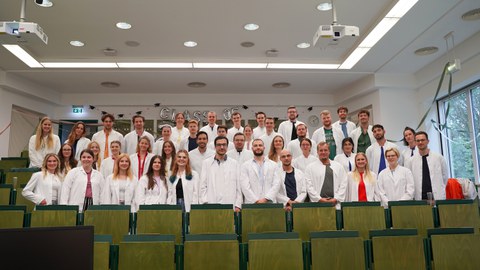Oct 24, 2025
Into practice: The practical year begins for the first cohort of the MEDiC model degree program at TU Dresden

The students of the first MEDiC class of 2020 at their final lecture in July 2025.
Today, on October 24, 2025, the first students of the model degree program in human medicine at the Faculty of Medicine of TUD Dresden University of Technology at the Chemnitz Medical Campus will celebrate the ceremonial completion of the theoretical part of their studies at the Chemnitz Opera House. Subsequently, they will start their practical year. This is the very first time that the curriculum, which was completely redesigned for the MEDiC model degree program in 2020, has been fully completed. Once the students have also completed their practical year and passed the final section of the three-part medical examination, they will receive their license to practice medicine. Ideally, they will then remain in the Southwest Saxony region as medical professionals. In addition to increasing the number of places to study medicine in Saxony, the main objective of the degree program is to strengthen the quality of young medical talent in rural areas.
Medical care in Germany is facing major challenges. The double impact of demographic change - the baby boomers are retiring (also as doctors) and at the same time increasingly require medical assistance due to age-related chronic illnesses - is combined with an insufficient number of newly trained doctors and a declining population in rural areas. This is particularly true for Saxony.
"We have taken a completely new approach with the MEDiC model degree program and have continuously developed medical studies in Saxony. With a clear focus on medical care in rural areas and with partner institutions that teach the indispensable medical profession in a practical way during their studies," says Saxony's Science Minister Sebastian Gemkow. "The majority of the first-year students are still planning their professional future here in the region. This is a great success and proves that it was the right decision to set up the model degree course in Chemnitz. In the coalition agreement, we agreed to establish the degree program permanently."
Prof. Michael Albrecht, Medical Director of Dresden University Hospital until the end of 2024, initiated the MEDiC project in 2018. Initially funded by the federal government, the Faculty of Medicine at TU Dresden was commissioned to design a model degree course and create 50 additional study places in medicine. The Dresden International University, the Saxon State Medical Association and the Association of Statutory Health Insurance Physicians were important partners in this project. As there had previously been no medical training in south-west Saxony, the new study places were intended to benefit this region. With Klinikum Chemnitz GmbH (KC) as the largest non-university maximum care hospital in Saxony, an essential local cooperation partner was acquired. The KC is supported by the Zeisigwaldkliniken Bethanien and the DRK Krankenhaus Rabenstein.
"For us as the Faculty of Medicine, the new study places are an opportunity to test innovative forms of teaching, concepts and care models in a model degree program that is fine-tuned to the changing framework conditions of medicine in the 21st century," explains Prof. Esther Troost, Dean of the Faculty of Medicine at TU Dresden. In addition to the pre-clinical and clinical study content, which has also been restructured, the specialist areas of healthcare research, public health, medical informatics and health systems research have been integrated into the training. In order to have the necessary expertise Prof. Marjo Wijnen-Meijer was appointed for medical didactics with a focus on interprofessional and interdisciplinary training and communication, alongside Prof. Markus Kösters for health services research.
"As a maximum care provider in south-west Saxony, we see it as our task to secure medical care in rural areas in the future," says Prof. Martin Wolz, Medical Director of Chemnitz Hospital. The MEDiC model course, in which students have a close connection to practice and the region right from the start, is intended to achieve this goal. "We hope that the students will feel at home in and around Chemnitz during the ten semesters and decide to spend their practical year, their further training and, in the best-case scenario, as trained doctors with long-term prospects in the south-west Saxony region."

Greetings from the 10th semester students to the first-year students of 2025.
"We would like to take this opportunity to thank the first-year students of MEDiC for their courage, commitment and patience. Together with us lecturers, the students have learned how to set up this model degree program, establish it, develop it further during ongoing operations and continuously improve it," says Dean of Studies Prof. Klaus Zöphel. "The first cohort has now completed ten semesters and is about to start the final stage of medical training, the practical year in an academic teaching hospital. We can all be proud of this."
In addition to innovative teaching content, the structured mentoring programs play a central role at MEDiC. Students benefit from peer mentoring right from the start their studies. Experienced fellow students make it easier to get started and promote networking within the cohort. From the second year onwards, students are also supported by mentors with scientific or clinical experience. This personal exchange enables them to get to know various medical professions at an early stage and to explore individual career paths. In this way, students are prepared in a targeted manner for the challenges of medical practice. As the degree program continues to grow, the mentoring programs are also being further developed. In the future, the programs will also support specialist medical training as well as doctoral and post-doctoral projects.
MEDiC at a glance
In the 2020/21 winter semester, the first 50 students began their studies in human medicine on TU Dresden's MEDiC model course at the Chemnitz Medical Campus. They have now completed their study phase of 10 semesters.
Content:
The model course serves as an innovation platform for testing new forms of teaching, concepts and care models in the environment of the maximum care hospital Klinikum Chemnitz and should be transferable to other regions as well as contribute to the promotion of medical innovations in south-west Saxony. It stands out from traditional training due to the organ-system-related and practice-oriented teaching in fields of competence. The use of digital teaching methods plays an essential role. Each semester was evaluated and adapted following the completion of the first year.
Allocation of study places:
In order to improve the chances of gaining a study place, MEDiC offers both a Test for Medical Degree Programs that is independent of the university (TMS) and selection interviews, which are taken into account in the application process: https: //tu-dresden.de/med/mf/studium/studienangebot/modellstudiengang-humanmedizin-staatsexamen/bewerbung
The degree program
The course is based on the licensing regulations for doctors and comprises 32 areas of competence. After two years of study, students take the first part of the equivalency examination, which corresponds to the first section of the medical examination. The second and third parts of the equivalence examination follow one year after passing the initial exams. After a further two years of study, the second part of the medical examination is taken. The practical year begins after the second stage has been successfully completed and is structured into four training stages. The third section of the medical examination takes place after completion of the practical year.
Further links:
MEDiC: https: //medic.med.tu-dresden.de/
CHE analysis
According to a recent analysis by the Center for Higher Education Development (CHE), Saxony is in the top third nationwide in terms of the number of medical study places in relation to the total number of first-year students. However, if the number of residents is taken as a basis, this positive value drops significantly. With 15 places per 100,000 inhabitants, the Free State only ranks in the middle of the field.
The analysis emphasizes that the establishment of medical study places is particularly worthwhile in regions where there are currently none: according to the evaluation, there appears to be a correlation between the availability of medical locations and a higher density of doctors in a region. The recommendation is therefore that regions with a shortage of doctors should use this as motivation to consider establishing a medical faculty, despite the high costs of medical study places.
Contact:
Anne-Stephanie Vetter
Staff Unit Public Relations
Carl Gustav Carus Faculty of Medicine of the TUD Dresden University of Technology
+49 (0) 351 458 17903
www.tu-dresden.de/med
Claudia Dietz
Head of Corporate Communications & Marketing
Chemnitz Hospital gGmbH
Flemmingstraße 2
09116 Chemnitz
www.klinikumchemnitz.de
